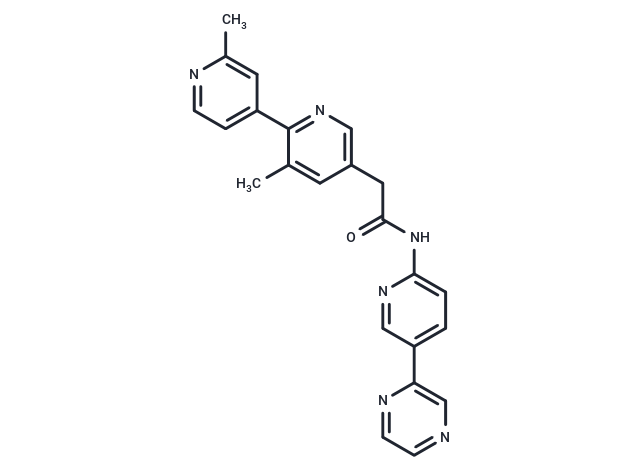Shopping Cart
- Remove All
 Your shopping cart is currently empty
Your shopping cart is currently empty

LGK974 (NVP-LGK974) is an effective and selective PORCN inhibitor and inhibits Wnt signaling (IC50: 0.4 nM) in TM3 cells. It has been used in trials studying the treatment of Metastatic Colorectal Cancer and Squamous Cell Carcinoma, Head And Neck.

| Pack Size | Price | Availability | Quantity |
|---|---|---|---|
| 1 mg | $41 | In Stock | |
| 2 mg | $59 | In Stock | |
| 5 mg | $97 | In Stock | |
| 10 mg | $167 | In Stock | |
| 25 mg | $319 | In Stock | |
| 50 mg | $573 | In Stock | |
| 100 mg | $819 | In Stock | |
| 1 mL x 10 mM (in DMSO) | $97 | In Stock |
| Description | LGK974 (NVP-LGK974) is an effective and selective PORCN inhibitor and inhibits Wnt signaling (IC50: 0.4 nM) in TM3 cells. It has been used in trials studying the treatment of Metastatic Colorectal Cancer and Squamous Cell Carcinoma, Head And Neck. |
| Targets&IC50 | Porcn:0.4 nM |
| In vitro | In both the MMTV-WNT1 mouse model of breast carcinoma and the human head and neck squamous cell carcinoma model (hn30), LGK-974 (3 mg/kg) inhibits the Wnt signaling pathway, leading to tumor regression without affecting mouse body weight. Additionally, LGK-974 (5 mg/kg, twice daily, orally) also suppresses the growth of RNF43-mutant pancreatic tumors (HPAF-II and Capan-2). |
| In vivo | LGK-974 inhibits a range of tested Wnts, with IC50 values between 0.05 to 2.4 nM. In the PORCN radioligand binding assay, LGK-974 effectively displaces [3H]GNF-1331 with an IC50 of 1 nM and exhibits minimal cytotoxicity at 20 μM. It specifically inhibits the growth of RNF43 mutant cell lines HPAF-II, PaTu 8988S, and Capan-2. |
| Kinase Assay | Radioligand binding assay: using the aforementioned membrane preps, filtration binding assays are performed. To reduce nonspecific binding, 96-well filtration plates are precoated as suggested by the manufacturer with 0.1% BSA and then washed four times with 0.1% BSA. Membrane preps (50 μg total protein) are incubated in polypropylene 96-well plates with 6.6 nM 3H-GNF-1331 in the presence or absence of a testing compound in binding buffer (50 mM Tris, pH 7.5, 5 mM MgCl2, 1 mM EDTA, 0.1% BSA) plus EDTA-free protease inhibitor mixture in a final volume of 150 μL for 3 h at room temperature. Binding reaction mixtures are then transferred to the precoated 96-well filtration plates, filtered, and washed using a 96-pin FilterMate Harvester. Radioactive signals are obtained using a Microplate Scintillation Counter TopCount. Curve fitting is performed using Prism[1]. |
| Cell Research | Cells are plated in growth medium in a 96-well plate at a density of 6,000–12,000 cells per well and treated with DMSO or 1 μM LGK974. After 3 d, the cells are treated with fresh growth medium containing 20 μM EdU, which is included in the Click-iT EdU Alexa Fluor 488 HCS assay kit, and the plate was incubated for 2 h at 37 °C in a humidi?ed atmosphere containing 5% CO2. Cells are ?xed with ?nal 4% (mass/vol) paraformaldehyde for 30 min, washed with PBS, permeabilized, and stained with 50 μg/mL Hoechst in PBS for 30 min. After wash, the cells are proceeded to EdU detection according to the instruction of Click-iT EdU assay kit. Triplet wells are performed for each condition. (Only for Reference) |
| Alias | WNT974, NVP-LGK974, LGK-974, LGK 974 |
| Molecular Weight | 396.44 |
| Formula | C23H20N6O |
| Cas No. | 1243244-14-5 |
| Smiles | Cc1cc(ccn1)-c1ncc(CC(=O)Nc2ccc(cn2)-c2cnccn2)cc1C |
| Relative Density. | 1.268 g/cm3 (Predicted) |
| Storage | Powder: -20°C for 3 years | In solvent: -80°C for 1 year | Shipping with blue ice. | |||||||||||||||||||||||||||||||||||
| Solubility Information | DMSO: 73 mg/mL (184.14 mM), Sonication is recommended. Ethanol: < 1 mg/mL (insoluble or slightly soluble) | |||||||||||||||||||||||||||||||||||
Solution Preparation Table | ||||||||||||||||||||||||||||||||||||
DMSO
| ||||||||||||||||||||||||||||||||||||

Copyright © 2015-2025 TargetMol Chemicals Inc. All Rights Reserved.